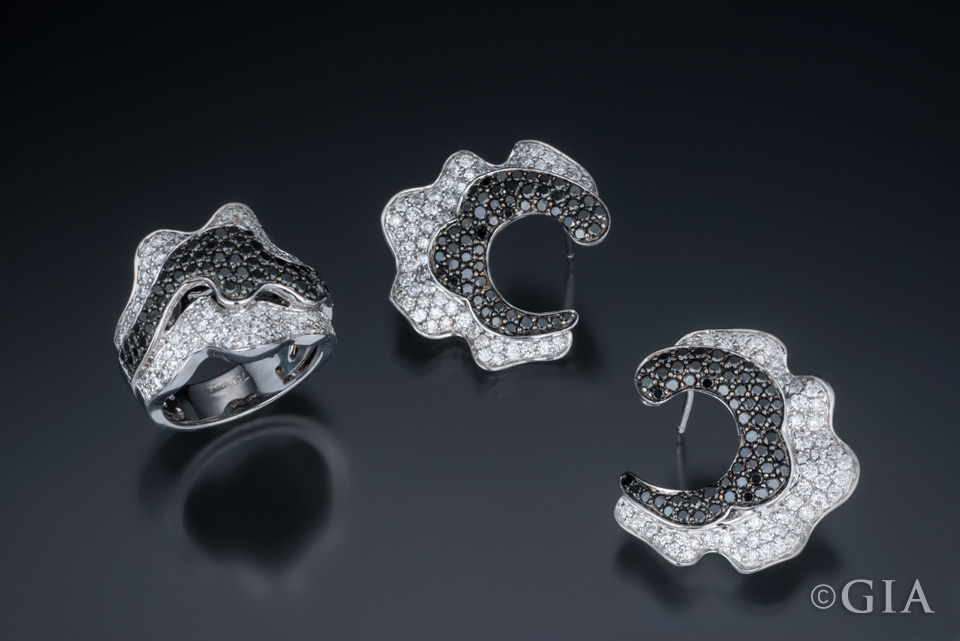With Halloween creeping up on us, black diamonds seem a fitting subject.
Black diamonds, much like brown diamonds, were once outcasts in the diamond world. In the 1928 book, Diamond: A Descriptive Treatise, author J.R. Sutton noted: “Ordinary black diamond is not greatly unlike black sealing wax. Opinions differ as to its virtues as a gemstone.” And until relatively recently, this negative impression still persisted.”

Black doesn’t have to be serious. Ricardo Basta’s platinum Panda brooch set with colorless diamonds, black diamonds, jade, and black onyx, is positively playful. Photo Robert Weldon/GIA. Courtesy of Ricardo Basta.
Then some talented jewelry designers stepped in, and gave the lowly black diamond’s image a serious makeover. They realized that black diamonds could create drama in a piece and make a serious statement. They recognized that black and white is a combination that never goes out of style (like colorless diamonds and platinum).

This suite of black and white diamond jewelry with a ring and earrings was on display at JCK Las Vegas 2014 – one of the jewelry industry’s largest trade shows. Photo by Robert Weldon/GIA, courtesy of Nanci Knott & Co.
Now to shed a little light on black diamonds: natural color black diamonds owe their color to an overabundance of very dark inclusions. These inclusions are typically microscopic concentrations of graphite, magnetite, hematite or native Fe (iron). Treated color black diamonds can be irradiated so they appear black but they’re actually a very dark green color or they can be subjected to low pressure, high-temperature annealing which induces large-scale graphitization within surface-reaching fractures.

This oxidized sterling silver ring is set with a large brown quartz in an 18K yellow gold bezel and accented with black diamonds in the shank. © Karin Jamieson Jewelry.
Natural color black diamonds are notoriously difficult to cut and polish. They have irregular growth patterns because they are polycrystalline, or aggregates of many diamond crystals. They are hard to polish because of numerous graphite inclusions and surface-reaching breaks that can cause pits. Because of this, natural color black diamonds tend to chip or break apart on the cutting wheel. They can take much longer to facet than colorless diamonds and the finished gems are more easily damaged. Sometimes transparent areas are surrounded by opaque zones caused by dense concentrations of dark inclusions; however, a homogenous black color is preferred.

Numerous eye-visible breaks on the surface of this natural color black diamond is common. Photo by John I. Koivula/GIA.
Since natural color black diamonds are difficult to cut and polish, manufacturers often irradiate industrial-grade diamonds to change their color to appear black. Some treated diamonds are heated at high temperatures, while others are exposed to gamma rays in a nuclear reactor: or to ion implantation in a linear accelerator.

Artificially irradiated black-appearing diamonds typically reveal a dark green coloration through thin, relatively transparent edges when examined with intense illumination. Photo by Robert E. Kane/GIA.
Natural color black diamonds are rare. Sellers should always disclose when a gemstone has been treated but with black diamonds, assume that most of them are treated.
In the market for a black diamond? You’ll definitely want to know if the color is natural or treated. An analysis from an independent laboratory like GIA will help you to be confident in your purchase – so don’t forget to ask for a lab report!
Custom Field: Array

